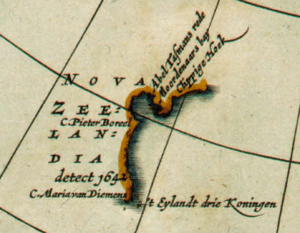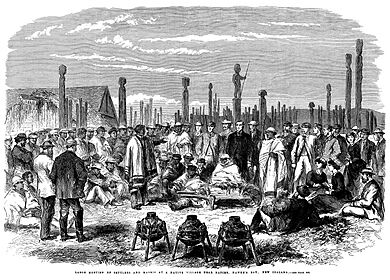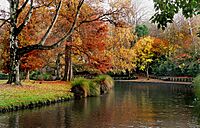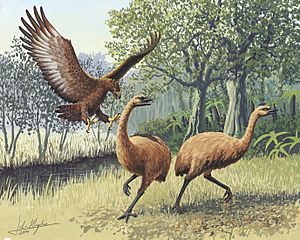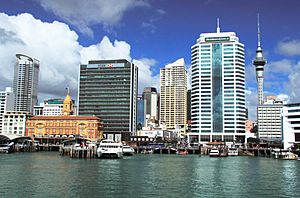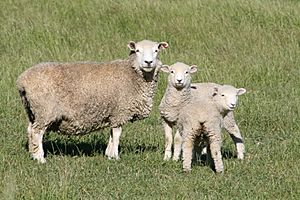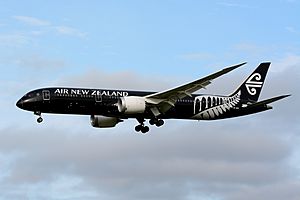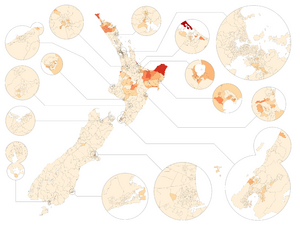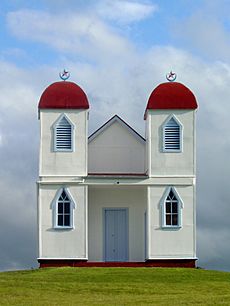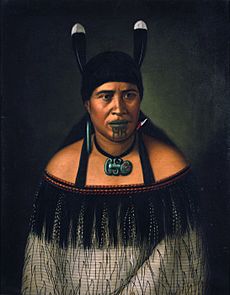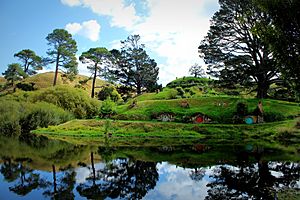New Zealand facts for kids
Quick facts for kids
New Zealand
Aotearoa (Māori)
|
|
|---|---|
| Capital | Wellington 41°18′S 174°47′E / 41.300°S 174.783°E |
| Largest city | Auckland |
| Official languages | |
| Ethnic groups
(2023)
|
|
| Religion
(2023)
|
|
| Demonym(s) |
|
| Government | Unitary parliamentary constitutional monarchy |
|
• Monarch
|
Charles III |
| Cindy Kiro | |
| Christopher Luxon | |
| Legislature | Parliament |
| Stages of independence
from the United Kingdom
|
|
| 6 February 1840 | |
| 7 May 1856 | |
|
• Dominion
|
26 September 1907 |
| 25 November 1947 | |
|
• Constitution Act 1986
|
1 January 1987 |
| Area | |
|
• Total
|
263,310 km2 (101,660 sq mi) (75th) |
|
• Water (%)
|
1.6 |
| Population | |
|
• December 2025 estimate
|
|
|
• 2023 census
|
|
|
• Density
|
19.5/km2 (50.5/sq mi) (167th) |
| GDP (PPP) | 2023 estimate |
|
• Total
|
|
|
• Per capita
|
|
| GDP (nominal) | 2023 estimate |
|
• Total
|
|
|
• Per capita
|
|
| Gini (2022) | ▼ 30.0 medium |
| HDI (2023) | very high · 17th |
| Currency | New Zealand dollar ($) (NZD) |
| Time zone | UTC+12 (NZST) |
|
• Summer (DST)
|
UTC+13 (NZDT) |
| Date format | dd/mm/yyyy |
| Driving side | left |
| Calling code | +64 |
| ISO 3166 code | NZ |
| Internet TLD | .nz |
New Zealand (which in the Māori language is called Aotearoa) is an amazing island country located far away in the southwestern Pacific Ocean. It's made up of two big main islands—the North Island (known as Te Ika-a-Māui in Māori) and the South Island (called Te Waipounamu)—plus more than 600 smaller islands! It's the sixth-largest island country by land area. New Zealand is east of Australia across the Tasman Sea and south of islands like New Caledonia, Fiji, and Tonga.
New Zealand's landscape is super varied, with sharp mountain peaks like the Southern Alps (Kā Tiritiri o te Moana). These mountains and valleys were formed by powerful tectonic uplift (when Earth's plates push up land) and volcanic eruptions. The capital city of New Zealand is Wellington, and its biggest city is Auckland.
The islands of New Zealand were some of the last places on Earth to be settled by humans. Between about 1280 and 1350, Polynesians arrived and created the unique Māori culture. In 1642, a Dutch explorer named Abel Tasman was the first European to see New Zealand. Later, in 1769, the British explorer Captain James Cook was the first European to actually land on and map the country.
A very important event happened in 1840: representatives from the United Kingdom and Māori chiefs signed the Treaty of Waitangi. This treaty set the stage for Britain to declare control over New Zealand later that year, and the Colony of New Zealand was officially formed in 1841. Over time, there were some conflicts between the colonial government and Māori tribes, which unfortunately led to a lot of Māori land being taken.
New Zealand became a self-governing country (called a Dominion) in 1907. It gained full independence in 1947, but still kept the monarch (the King or Queen) as its head of state. Today, most of New Zealand's population of over 5 million people are of European descent. The native Māori people are the largest minority group, followed by people of Asian and Pacific Island backgrounds. Because of this mix, New Zealand's culture is a blend of Māori and early British traditions, but it's also growing with new influences from recent immigrants.
The official languages are English, Māori, and New Zealand Sign Language. The local way of speaking English, called New Zealand English, is the most common.
New Zealand is considered a developed country. It was actually the first country in the world to introduce a minimum wage and give women the right to vote! It ranks very high for quality of life and human rights, and has very low levels of corruption. However, there are still some differences in wealth and opportunities, especially for Māori people.
In the 1980s, New Zealand made big changes to its economy, moving from a protected economy to a more open, free-trade one. The service industry (like tourism and finance) is the biggest part of New Zealand's economy, followed by manufacturing and farming. International tourism is also a huge earner for the country. New Zealand and Australia have a very strong connection, often seen as sharing a "Trans-Tasman" identity. New Zealand is also part of many international groups and forums.
New Zealand has a Parliament that makes laws. The government is led by the Prime Minister, who is currently Christopher Luxon. Charles III is the King of New Zealand, and he is represented by the Governor-General, Cindy Kiro. New Zealand is divided into 11 regions and 67 local areas for local government. The Realm of New Zealand also includes Tokelau (a dependent territory), the Cook Islands and Niue (self-governing states closely linked to New Zealand), and the Ross Dependency, which is New Zealand's claim in Antarctica.
Contents
What's in a Name? The Story of New Zealand's Names
The first European to visit New Zealand, Dutch explorer Abel Tasman, called the islands Staten Land. He thought they were part of a land he knew off the southern tip of South America. But later, Dutch mapmakers realized they were wrong and renamed Tasman's discovery Nova Zeelandia (which is Latin for "New Zeeland"), after a Dutch province called Zeeland. This name was later changed to New Zealand in English.
In the Māori language, New Zealand was sometimes written as Nu Tireni. In 1834, a document called the Declaration of the Independence of New Zealand was written in Māori, and it was recognized by the British King William IV.
The most common Māori name for New Zealand today is Aotearoa. This name is often translated as 'land of the long white cloud'. It's not clear if Māori had one name for the whole country before Europeans arrived; Aotearoa originally referred only to the North Island. The Māori had different traditional names for the two main islands: Te Ika-a-Māui (meaning 'the fish of Māui') for the North Island, and Te Waipounamu (meaning 'the waters of greenstone') or Te Waka o Aoraki (meaning 'the canoe of Aoraki') for the South Island.
Early European maps just called the islands North, Middle (for the South Island), and South (for Stewart Island). By 1907, "North" and "South" were the usual names for the two biggest islands. In 2013, the New Zealand Geographic Board officially recognized both the English and Māori names for the islands: North Island or Te Ika-a-Māui, and South Island or Te Waipounamu. You can use either name, or both together! Sometimes, people also say Aotearoa New Zealand to include both the Māori and English names for the whole country, but this isn't officially recognized.
A Look Back: New Zealand's History
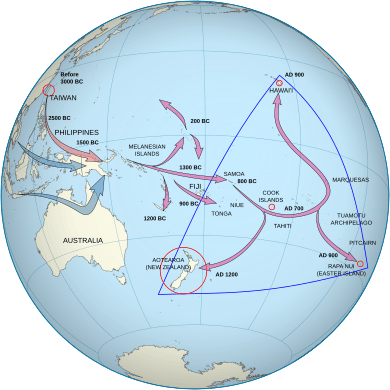
The first people to arrive in New Zealand were Polynesians, who travelled in large ocean-going canoes called waka. They are thought to have arrived in several groups between about 1280 and 1350 CE. Māori oral traditions say that the islands were first found by a legendary explorer named Kupe. Later, a "great fleet" of settlers supposedly came from a place called Hawaiki in eastern Polynesia around 1350. However, modern research suggests that the settlement was a planned event that happened over several decades, not just one big fleet.
In 1642, the Dutch explorer Abel Tasman had a bad encounter with the Ngāti Tūmatakōkiri tribe, and four of his crew were killed. Europeans didn't visit New Zealand again until 1769, when the British explorer James Cook mapped almost the entire coastline. After Cook, many European and North American whaling, sealing, and trading ships visited. They traded things like metal tools and weapons for timber, Māori food, and other goods.
The introduction of potatoes and muskets (a type of gun) changed Māori farming and warfare. Potatoes gave them a lot of food, which allowed for longer wars. The Musket Wars (1801-1840) were a series of tribal conflicts that killed many Māori. In the early 1800s, Christian missionaries also started settling in New Zealand and eventually many Māori became Christians. Sadly, the Māori population dropped a lot during the 19th century, mainly because of new diseases brought by Europeans.
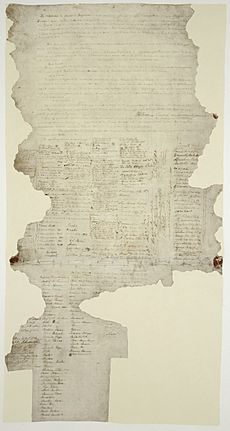
In 1832, the British Government sent James Busby to New Zealand as a British Resident to protect settlers and prevent problems with Māori. In 1835, Māori chiefs sent a Declaration of the Independence of New Zealand to King William IV of the United Kingdom asking for protection. Because of ongoing issues and plans by the New Zealand Company to buy land, the British sent Captain William Hobson to claim control and make a treaty with the Māori.
The Treaty of Waitangi was first signed on 6 February 1840. Hobson then declared British control over all of New Zealand on 21 May 1840. After the treaty was signed, more immigrants, especially from the United Kingdom, started to arrive.
New Zealand was part of the Colony of New South Wales until it became its own Crown colony on 3 May 1841. Conflicts between the colonial government and Māori began in 1843 over land and disagreements about who had control. These conflicts, known as the New Zealand Wars, mainly happened in the North Island. After these wars, large areas of Māori land were taken by the government.
New Zealand gained a representative government in 1852, and its first Parliament met in 1854. By 1856, the colony was largely self-governing. In 1865, Wellington was chosen as the new capital city because of its central location.
In 1891, the Liberal Party came to power and passed many important social and economic laws. In 1893, New Zealand became the first nation in the world to give all women the right to vote. They also introduced a minimum wage in 1894, another world first.
In 1907, New Zealand officially became a Dominion within the British Empire, showing its self-governing status. In 1947, New Zealand fully adopted the Statute of Westminster, meaning the British Parliament could no longer make laws for New Zealand without its permission.
In the 20th century, New Zealand played a part in world events, fighting in both the First and Second World Wars. The country also went through the Great Depression. After the Second World War, New Zealand became more prosperous, and Māori people started moving from rural areas to cities for work. A Māori protest movement grew, pushing for more recognition of Māori culture and the Treaty of Waitangi. In 1975, the Waitangi Tribunal was set up to investigate claims of breaches of the Treaty. The government has since worked to settle many of these grievances with Māori tribes.
Amazing Nature: Geography and Environment

New Zealand is made up of two main islands and over 700 smaller ones. The North Island (Te Ika-a-Māui) and the South Island (Te Waipounamu) are separated by Cook Strait, which is only about 22 km (14 miles) wide at its narrowest point. Other important inhabited islands include Stewart Island (across the Foveaux Strait), Chatham Island, and Great Barrier Island.
New Zealand is long and narrow, stretching over 1,600 km (990 miles) with a maximum width of 400 km (250 miles). It has a huge coastline of about 15,000 km (9,300 miles) and a total land area of 268,000 square km (103,000 sq mi). Because of its many islands and long coastline, New Zealand has a massive exclusive economic zone (EEZ) in the ocean, which is more than 15 times its land area!

The South Island is the largest landmass and is split down its length by the Southern Alps. There are 18 peaks over 3,000 metres (9,800 ft) high, with the tallest being Aoraki / Mount Cook at 3,724 metres (12,218 ft). The Fiordland area in the southwest of the South Island has steep mountains and deep fiords, carved out by glaciers during the ice ages. The North Island is less mountainous but has a lot of volcanoes. The very active Taupō Volcanic Zone has created a large volcanic plateau, with the North Island's highest mountain, Mount Ruapehu (2,797 m or 9,177 ft), being a volcano. This plateau also has New Zealand's largest lake, Lake Taupō, which sits in the crater of one of the world's most active supervolcanoes. New Zealand often experiences earthquakes.
New Zealand's unique landscape is due to its position on the dynamic boundary between the Pacific Plate and Indo-Australian Plate. About 25 million years ago, these plates started to push and fold the land, creating the Southern Alps.
New Zealand is part of a larger region called Australasia (which also includes Australia). It's also the southwestern tip of Polynesia. The wider region of Oceania includes Australia, New Zealand, and many Pacific island countries.
Weather and Climate
New Zealand generally has a mild maritime climate. This means it has moderate temperatures, not too hot and not too cold. Average yearly temperatures range from 10°C (50°F) in the south to 16°C (61°F) in the north. However, conditions can change a lot across different regions. For example, the West Coast of the South Island is very wet, while Central Otago is quite dry. Northland in the far north has a subtropical climate.
Of the seven largest cities, Christchurch is the driest, getting only about 618 mm (24 inches) of rain per year. Wellington is the wettest, with almost twice that amount. Auckland, Wellington, and Christchurch all get more than 2,000 hours of sunshine each year. The southern parts of the South Island are cooler and cloudier, while the northern and northeastern parts of the South Island are the sunniest, with about 2,400–2,500 hours of sunshine. Snow usually falls from early June to early October, especially in the eastern and southern parts of the South Island and in mountain areas across the country.
| Location | January high °C (°F) |
January low °C (°F) |
July high °C (°F) |
July low °C (°F) |
Annual rainfall mm (in) |
|---|---|---|---|---|---|
| Auckland | 23 (73) | 15 (59) | 15 (59) | 8 (46) | 1212 (47.7) |
| Wellington | 20 (68) | 14 (57) | 11 (52) | 6 (43) | 1207 (47.5) |
| Hokitika | 20 (68) | 12 (54) | 12 (54) | 3 (37) | 2901 (114.2) |
| Christchurch | 23 (73) | 12 (54) | 11 (52) | 2 (36) | 618 (24.3) |
| Alexandra | 25 (77) | 11 (52) | 8 (46) | ||
| 359 (14.1) |
Unique Wildlife: Biodiversity
New Zealand has been isolated for about 80 million years, which has led to the evolution of many unique animals, fungi, and plants. About 82% of New Zealand's native plants are found nowhere else in the world! Before humans arrived, about 80% of the land was covered in forest.
The forests were full of birds. Because there were no land mammals that hunted, some birds like the kiwi, kākāpō, weka, and takahē lost their ability to fly. But when humans arrived, they changed habitats and brought new animals like rats and ferrets. This led to the extinction of many bird species, including huge birds like the moa and the Haast's eagle.
Other native animals include reptiles like the tuatara (which is so unique it's called a "living fossil"), frogs, spiders, insects (like the wētā), and snails. Until 2006, the only native land mammals known were three species of bats (one of which is now extinct). However, marine mammals are plentiful, with almost half of the world's cetaceans (whales, dolphins, and porpoises) and many fur seals found in New Zealand waters. Many seabirds also breed here, and a third of them are unique to the country. New Zealand has more penguin species than any other country, with 13 of the world's 18 species!
Sadly, since humans arrived, almost half of New Zealand's native vertebrate species have become extinct. Many others are endangered. But New Zealand conservationists have developed special ways to help threatened wildlife, like creating island sanctuaries, controlling pests, moving animals to new safe places, and restoring natural habitats.
How New Zealand is Run: Government and Politics
New Zealand is a constitutional monarchy with a parliamentary democracy. This means it has a King (or Queen) as its head of state, but the real power is held by an elected Parliament. Charles III is the King of New Zealand. He is represented by the Governor-General, who is appointed on the advice of the Prime Minister. The Governor-General has some special powers, but usually uses them only with the government's advice.
The New Zealand Parliament makes the laws. It includes the King and the House of Representatives. The House of Representatives is made up of people chosen by voters. The government is formed by the political party or group of parties that wins the most seats in Parliament. The Prime Minister is the leader of this governing party or coalition. The Cabinet, made up of ministers led by the Prime Minister, makes the most important decisions for the country.
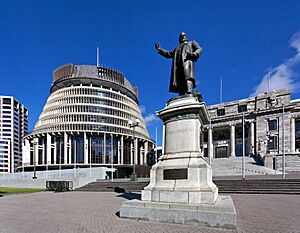
A general election for Parliament must be held at least every three years. Since 1996, New Zealand has used a voting system called mixed-member proportional (MMP). In this system, you get two votes: one for a candidate in your local area (called an electorate) and one for a political party. This system helps make sure that the number of seats a party gets in Parliament is similar to the percentage of votes they received.
New Zealand's court system is led by the Chief Justice. Judges are appointed without political influence to ensure they can make fair decisions based only on the law.
New Zealand is known as one of the most stable and well-governed countries in the world. As of 2023, it ranks very high for strong democratic institutions and low corruption. LGBT rights are also very well recognized. New Zealanders are very involved in politics, with high voter turnout in general elections. However, turnout for local elections is much lower. A human rights report in 2017 noted that while the government generally respects individual rights, there are still concerns about the social status of the Māori population and some differences in the criminal justice system.
Regions and Territories
New Zealand is divided into 11 regional councils and 67 territorial authorities for local government. Regional councils manage things like the natural environment and resources, while territorial authorities handle local services like water, roads, and building permits. Some areas have "unitary authorities" that do both jobs.
The Realm of New Zealand is the entire area where the King of New Zealand is the sovereign. It includes New Zealand itself, Tokelau (a dependent territory), the Cook Islands and Niue (self-governing states that are closely linked to New Zealand), and the Ross Dependency (New Zealand's claim in Antarctica). People born in any of these places are generally New Zealand citizens.
Global Connections: Foreign Relations

For a long time, Britain handled New Zealand's foreign trade and relations. But in the 1920s, New Zealand gained the right to make its own international agreements. On 3 September 1939, New Zealand joined Britain in declaring war on Germany.
In 1951, New Zealand joined Australia and the United States in the ANZUS security treaty. However, New Zealand's relationship with the United States changed after protests against the Vietnam War and New Zealand's nuclear-free policy. Even though the US suspended some ANZUS obligations, the treaty remains strong between New Zealand and Australia. The two countries have very close ties, with free trade agreements and travel arrangements that let citizens live and work in both countries easily. In 2013, about 650,000 New Zealand citizens lived in Australia!
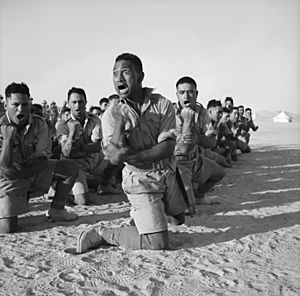
New Zealand has a strong presence in the Pacific Island countries, with good relationships with Samoa, Fiji, and Tonga. A lot of New Zealand's aid goes to these countries, and many Pacific Islanders move to New Zealand for work. New Zealand is also part of many international groups like the United Nations, the Commonwealth of Nations, and the Organisation for Economic Co-operation and Development (OECD).
Today, New Zealand has especially close relationships with the United States and Australia. It's also part of the Five Eyes intelligence-sharing agreement with Australia, Canada, the United Kingdom, and the United States. According to the 2024 Global Peace Index, New Zealand is the 4th most peaceful country in the world.
New Zealand's Military
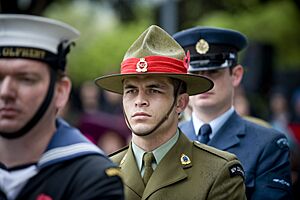
New Zealand's military, called the New Zealand Defence Force, includes the Royal New Zealand Navy, the New Zealand Army, and the Royal New Zealand Air Force. While a direct attack on New Zealand is unlikely, its military has been involved in conflicts and peacekeeping missions around the world.
New Zealand fought in both world wars, with important campaigns in Gallipoli, Crete, and Cassino. The Gallipoli campaign was especially important in shaping New Zealand's national identity and strengthening the ANZAC tradition it shares with Australia.
Besides the world wars, New Zealand has fought in the Second Boer War, the Korean War, the Malayan Emergency, the Gulf War, and the Afghanistan War. It has also sent forces to many peacekeeping missions in places like Cyprus, Somalia, Bosnia and Herzegovina, and the Solomon Islands.
New Zealand's Economy
New Zealand has an advanced market economy. It ranks 16th in the 2022 Human Development Index and fourth in the 2022 Index of Economic Freedom. It's a high-income economy with a gross domestic product (GDP) per person of about US$36,254. The currency is the New Zealand dollar, often called the "Kiwi dollar."
Historically, New Zealand's economy relied on industries that extracted natural resources, like sealing, whaling, and gold mining. In 1882, the first shipment of refrigerated meat on the ship Dunedin led to a big boom in meat and dairy exports to Britain. This trade helped New Zealand's economy grow a lot. In the 1950s and 1960s, New Zealanders actually had a higher standard of living than people in Australia and Western Europe!
However, in 1973, New Zealand's export market was hit hard when the United Kingdom joined the European Economic Community. This, along with oil crises, led to a tough economic depression. By 1982, New Zealand had the lowest income per person among developed nations surveyed by the World Bank. In the mid-1980s, the government made big changes, transforming New Zealand from a protected economy to a more open, free-trade one.
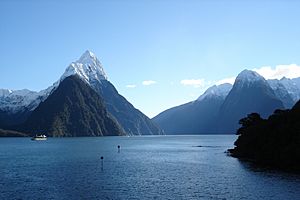
Unemployment reached over 10% in the early 1990s but fell to a low of 3.7% in 2007. The 2008 financial crisis caused another recession, and unemployment rose again. However, in December 2021, during the COVID-19 pandemic, unemployment hit a record low of 3.2%. New Zealand has experienced a "brain drain" since the 1970s, with many skilled workers moving overseas, especially to Australia and Britain. But in recent decades, a "brain gain" has brought educated professionals from other countries to New Zealand.
There are still some challenges, like growing income inequality. Wealth is highly concentrated, with the richest 1% of the population owning 16% of the country's wealth. Child poverty in New Zealand is also a big issue, with a higher percentage of Māori and Pacific Islander children living in low-income households.
Trade and Industries
New Zealand relies heavily on international trade, especially in agricultural products. Exports make up 24% of its economic output, which means New Zealand can be affected by global prices and economic slowdowns. In 2014, food products made up 55% of all exports, with wood being the second largest earner. New Zealand's main trading partners are China, Australia, the European Union, the United States, and Japan. In 2008, New Zealand and China signed a free trade agreement, the first China signed with a developed country. In 2023, New Zealand and the European Union also entered into a free trade agreement.
The service sector (like tourism, banking, and education) is the largest part of New Zealand's economy, followed by manufacturing and construction, and then farming and raw material extraction. Tourism is a very important part of the economy, contributing billions of dollars to New Zealand's GDP and supporting many jobs.
Wool used to be New Zealand's main agricultural export in the late 1800s. Even in the 1960s, it made up over a third of all export money. But its price has dropped, and it's not as profitable for many farmers anymore. In contrast, dairy farming has grown a lot, with the number of dairy cows doubling between 1990 and 2007. Dairy products are now New Zealand's largest export earner. The country's biggest company, Fonterra, controls almost one-third of the international dairy trade. Other important exports include meat, wood, fruit, and wine. New Zealand's wine industry has also grown significantly, even surpassing wool exports in 2007.
Infrastructure and Technology
In 2015, renewable energy generated over 40% of New Zealand's total energy supply. Most of the country's electricity comes from hydroelectric power (dams), especially on the Waikato, Waitaki, and Clutha rivers. Geothermal power (using heat from the Earth) is also a big source of electricity, with several large stations in the North Island.
New Zealand's transport network includes about 94,000 km (58,000 miles) of roads and 4,128 km (2,565 miles) of railway lines. Most people travel by private car. The country's railways were privatized in 1993 but were bought back by the government between 2004 and 2008. The state-owned company KiwiRail now runs most of the railways, mainly for freight. Ferries connect the road and rail networks between the North and South Islands. Most international visitors arrive by air. New Zealand has four international airports: Auckland, Christchurch, Queenstown, and Wellington.
New Zealand's telecommunications industry was privatized in 1990. While one company, Chorus, still owns most of the infrastructure, there's more competition now. A large project to roll out super-fast fibre to the premises internet (called Ultra-Fast Broadband) began in 2009, aiming to reach most of the population by 2022.
Science and Innovation
Māori people contributed to early science in New Zealand, with tohunga (experts) gaining knowledge of farming and herbal medicines. Explorers like James Cook and Charles Darwin also made important scientific observations. In the 19th century, universities were established, leading to discoveries by famous New Zealanders such as Ernest Rutherford (who split the atom), William Pickering (rocket science), and Maurice Wilkins (who helped discover DNA).
New Zealand invests in research and development (R&D), and its innovation level is high. The New Zealand Space Agency was created in 2016, and Rocket Lab is a notable commercial rocket company based in the country. Many private research organizations focus on agriculture and fisheries.
Who Lives in New Zealand? Demographics

The 2023 census counted 4,993,923 people living in New Zealand. As of December 2025, the population is estimated to be 5,231,143. New Zealand's population has been growing steadily.
Most of New Zealand's population lives in the North Island (around 77%) compared to the South Island (around 23%). Over the 20th century, more people moved north.
New Zealand is mostly an urban country, with about 86% of the population living in urban areas. About 33% of the population lives in the seven cities with over 100,000 people. Auckland, with over 1.4 million residents, is by far the largest city. New Zealand cities often rank highly for how good they are to live in.
The average age of people in New Zealand in 2018 was 37.4 years. Life expectancy in 2017–2019 was 80.0 years for males and 83.5 years for females.
Different Cultures: Ethnicity and Immigration
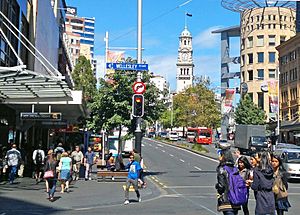
In the 2023 census, about 67.8% of New Zealand residents identified as European, and 17.8% as Māori. Other big ethnic groups include Asian (17.3%) and Pacific peoples (8.9%). New Zealand has a very diverse population, with many people identifying with more than one ethnic group. The population has become much more multicultural in recent decades. For example, in 1961, 92% of the population was European and 7% Māori.
The informal nickname for a New Zealander is "Kiwi". The Māori word Pākehā is often used to refer to New Zealanders of European descent.
The Māori were the first people to arrive in New Zealand, followed by early European settlers. After colonization, most immigrants came from Britain, Ireland, and Australia. Later, people from the Netherlands, Dalmatia, Germany, and Italy also immigrated. After the Second World War, immigration policies became more relaxed, and more people started coming from Asia. In the 2018 census, 27.4% of people were born outside New Zealand. Over half of New Zealand's overseas-born population lives in the Auckland Region. The United Kingdom is still the largest source of immigrants, followed by China, India, Australia, South Africa, Fiji, and Samoa.
Languages Spoken
English is the main language in New Zealand, spoken by 95.4% of the population. New Zealand English has its own unique accent and words, similar to Australian English.
After the Second World War, Māori people were often discouraged from speaking their language (te reo Māori) in schools and workplaces. But recently, there's been a big effort to bring the language back. It was declared one of New Zealand's official languages in 1987, and 4.0% of the population now speaks it. There are now Māori language-immersion schools and TV channels that broadcast mainly in Māori. Many places in New Zealand have both their Māori and English names officially recognized.
According to the 2018 census, Samoan is the most widely spoken non-official language (2.2%), followed by Mandarin Chinese (2.0%), Hindi (1.5%), and French (1.2%). New Zealand Sign Language became an official language in 2006 and is understood by about 0.5% of the population.
Beliefs: Religion
At the 2023 census, 51.6% of the population said they had no religion, which is an increase from 2018. Christians are the largest religious group, making up 32.3% of the population. Hindus are the second largest religious minority (2.9%), followed by Muslims (1.5%). The Auckland Region has the most diverse mix of religions.
Learning and Education
Primary and secondary school is required for children aged 6 to 16, but most children start at age 5. There are 13 school years, and attending state (public) schools is free for New Zealand citizens and permanent residents. New Zealand has a very high adult literacy rate of 99%. Over half of the population aged 15 to 29 have a tertiary qualification (like a university degree or diploma).
There are different types of government-owned higher education institutions: universities, colleges of education, polytechnics, specialist colleges, and wānanga (Māori places of learning), plus private training places. In 2021, 35% of people aged 25–64 had a bachelor's degree or higher. New Zealand ranks well in international assessments for maths, science, and reading.
New Zealand's Culture
Early Māori people adapted their tropical Polynesian culture to the new environment of New Zealand, developing their own unique way of life. Their society was very communal, with families (whānau), subtribes (hapū), and tribes (iwi) led by a chief (rangatira). British and Irish immigrants brought their own culture, and also influenced Māori culture, especially with Christianity. However, Māori still feel a strong connection to their tribal groups, which is a key part of their identity. More recently, cultures from America, Australia, Asia, and other parts of Europe have also influenced New Zealand. Other Polynesian cultures are also celebrated, with Pasifika (the world's largest Polynesian festival) held annually in Auckland.
In early New Zealand, life was mostly rural, which led to the idea that New Zealanders were tough, hardworking problem-solvers. Modesty was important, and people who achieved a lot were sometimes criticized (this was called "tall poppy syndrome"). From the early 1900s until the late 1960s, Māori culture was often suppressed as people tried to make Māori fit into British New Zealand ways. In the 1960s, as more people went to university and cities grew, urban culture became more important. However, rural images and themes are still common in New Zealand art, literature, and media.
New Zealand's national symbols are inspired by nature, history, and Māori culture. The silver fern is a famous emblem seen on army uniforms and sports teams. Certain popular items unique to New Zealand are called "Kiwiana".
Art and Creativity
As Māori culture has seen a comeback, traditional crafts like carving and weaving are now more widely practiced, and more Māori artists are becoming famous. Most Māori carvings feature human figures, often with spirals and other patterns. Traditional Māori buildings, called wharenui (meeting houses), were decorated with symbolic carvings and illustrations.
Māori also used red and black paints to decorate wood and painted pictures on cave walls. Māori tattoos (moko) were created by cutting designs into the skin. After Europeans arrived, paintings and photographs often showed New Zealand landscapes. Portraits of Māori people were also common. New Zealand's isolation meant that local artists developed their own unique style. In the 1960s and 1970s, many artists combined Māori and Western techniques to create new art forms. New Zealand art and craft is now gaining international attention.
Māori cloaks are made from fine flax fibre and decorated with black, red, and white patterns. Greenstone (a type of jade) was made into earrings and necklaces, with the most famous design being the hei-tiki, a stylized human figure. Europeans brought their fashion to New Zealand, and until the 1950s, people often dressed up for social events. Now, New Zealand fashion is known for being more casual and practical. However, the local fashion industry has grown a lot since 2000, with some labels becoming internationally recognized.
Literature and Stories
Māori quickly started writing down their ideas, and many of their oral stories and poems were put into written form. Early English literature in New Zealand mostly came from Britain. It wasn't until the 1950s, when more local publishers appeared, that New Zealand literature became widely known. Writers in the 1930s started focusing more on their experiences in New Zealand. After the world wars and with the growth of universities, local literature really flourished. Dunedin is recognized as a UNESCO City of Literature.
Music, Movies, and Fun
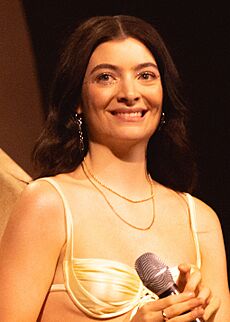
New Zealand music has been influenced by blues, jazz, country, rock and roll, and hip hop, but often with a unique New Zealand twist. Māori developed a rich musical tradition with songs and chants, using instruments like flutes and percussion. Early European settlers brought their own music, and brass bands and choirs were popular. The New Zealand recording industry grew from the 1940s, and many New Zealand musicians have found success internationally. Some artists release Māori language songs, and the traditional Māori art of kapa haka (song and dance) has become very popular again.
Public radio started in New Zealand in 1922, and state-owned television began in 1960. In the 1980s, more radio and TV stations appeared. New Zealand TV mostly shows American and British programs, along with many Australian and local shows. The number of New Zealand films grew a lot in the 1970s. The New Zealand Film Commission was created in 1978 to help local filmmakers, and many New Zealand films have gained international recognition. Some of the most successful New Zealand films include Hunt for the Wilderpeople, Boy, The World's Fastest Indian, and The Piano. New Zealand's beautiful scenery and government support have also attracted big international movie productions, like The Lord of the Rings and The Hobbit film trilogies, Avatar, and King Kong.
Food and Cuisine
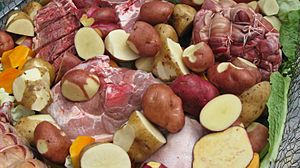
New Zealand's national food style is often called "Pacific Rim cuisine." It mixes native Māori cuisine with cooking traditions from European, Polynesian, and Asian settlers. New Zealand has a lot of fresh produce from land and sea. Some unique ingredients or dishes include lamb, salmon, kōura (crayfish), Bluff oysters, whitebait, pāua (abalone), mussels, scallops, pipi and tuatua (types of shellfish), kūmara (sweet potato), kiwifruit, tamarillo, and pavlova (a dessert considered a national dish). A hāngī is a traditional Māori way of cooking food using heated rocks buried in a pit oven; it's still used for large groups on special occasions.
Sports and Adventure

Most of the major sports played in New Zealand came from Britain. Rugby union is considered the national sport and is very popular. Golf, netball, tennis, and cricket are also widely played. Horse racing used to be very popular. About 54% of New Zealand teenagers play sports for their school.
Māori people have always been very involved in rugby, and the national team performs a haka (a traditional Māori challenge) before international matches. New Zealand is also famous for extreme sports, adventure tourism, and its strong mountaineering tradition, with famous climbers like Sir Edmund Hillary. Other popular outdoor activities include cycling, fishing, swimming, running, tramping, canoeing, hunting, snowsports, surfing, and sailing. New Zealand has had a lot of success in the America's Cup sailing competition.
New Zealand has strong international teams in rugby union, rugby league, netball, cricket, softball, and sailing. New Zealand first participated in the Summer Olympics on its own in 1920. The All Blacks, the national rugby union team, are one of the most successful rugby teams in the world, having won the Rugby World Cup three times.
See also
 In Spanish: Nueva Zelanda para niños
In Spanish: Nueva Zelanda para niños




